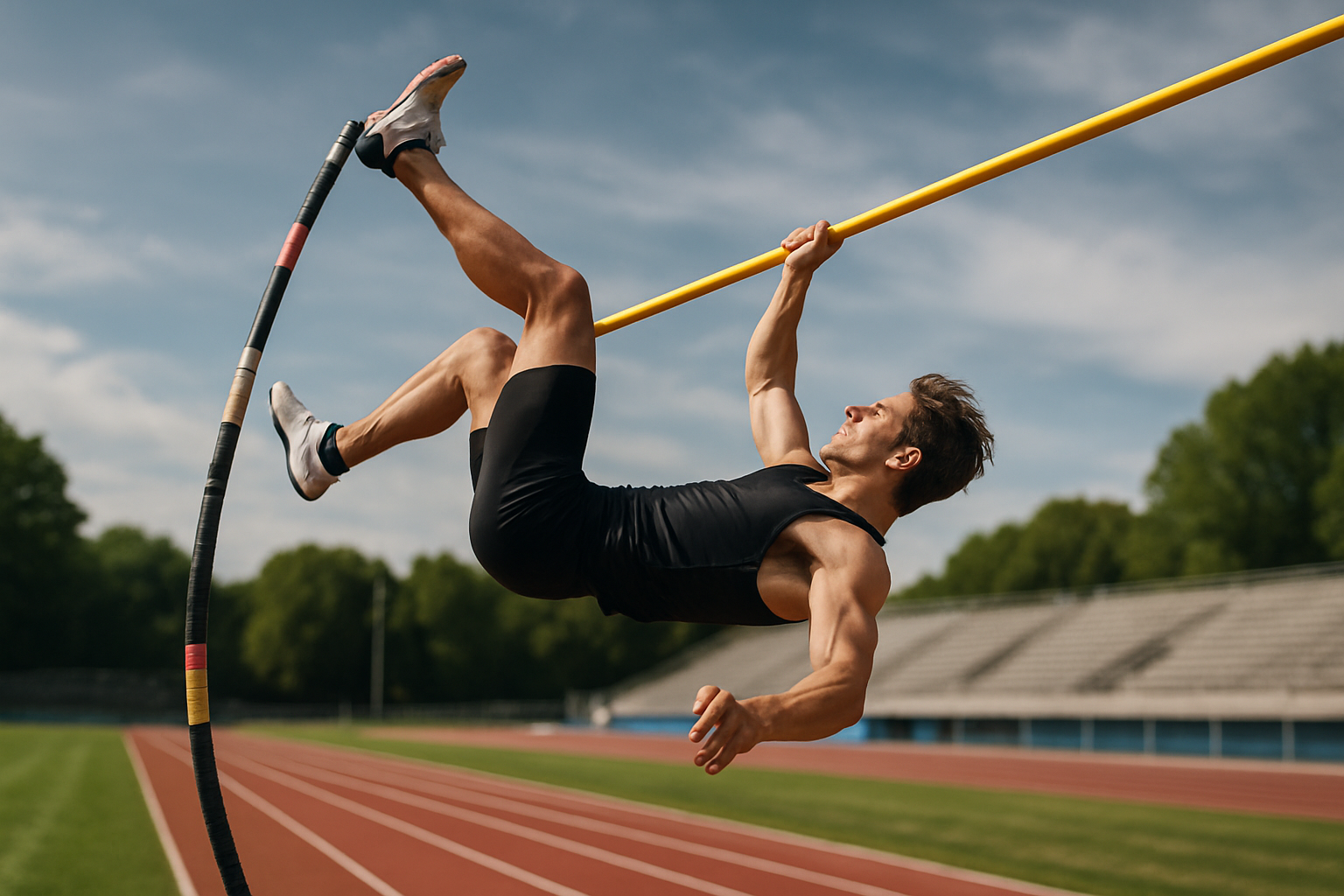Biomechanics of Pole Vaulting: Pushing the Limits of Human Flight
In the realm of athletics, few events captivate audiences quite like pole vaulting. This unique discipline combines raw power, precise technique, and a touch of aerial artistry. As vaulters soar to seemingly impossible heights, they challenge our understanding of human physical limits. But what exactly happens during those crucial seconds when an athlete transforms horizontal momentum into vertical flight? Let's delve into the fascinating world of pole vault biomechanics and uncover the science behind this gravity-defying feat.

As the vaulter sprints down the runway, they generate kinetic energy. This energy is then transferred into the flexible pole during the plant phase. The pole bends, storing this energy as potential energy in its fibers. As the pole straightens, it returns this energy to the vaulter, launching them upward. However, the efficiency of this energy transfer depends on numerous factors, including the vaulter’s technique, timing, and the characteristics of the pole itself.
The pole acts as an energy storage device, much like a spring. Its ability to bend and recoil is crucial to the vault’s success. Modern poles, typically made from fiberglass or carbon fiber, are engineered to maximize this energy return while maintaining the necessary strength and flexibility.
The Approach: Building the Foundation
A successful vault begins long before the athlete leaves the ground. The approach phase is a critical component that sets the stage for everything that follows. Vaulters typically use a run of about 40 meters, gradually building speed as they near the planting box.
During this phase, athletes must maintain a delicate balance between speed and control. Too much speed can lead to an unstable plant, while too little will result in insufficient energy for a high vault. Elite vaulters often reach speeds of up to 9 meters per second during their approach.
The final steps of the approach are particularly crucial. Vaulters must make subtle adjustments to their stride length and frequency to ensure they hit their takeoff point with precision. This requires exceptional spatial awareness and body control, as even small deviations can significantly impact the vault’s outcome.
The Plant and Take-off: The Moment of Truth
As the vaulter reaches the end of their approach, they enter the plant phase. This is perhaps the most technically demanding part of the vault, requiring split-second timing and flawless execution.
The athlete must lower the pole into the planting box while simultaneously driving their body upward and forward. The lower hand, which grips the pole near its end, acts as a fulcrum around which the vaulter’s body rotates. The upper hand, positioned higher on the pole, helps to guide and control this rotation.
During the plant, the vaulter’s body experiences forces of up to five times their body weight. Their muscles and joints must be conditioned to withstand these forces while maintaining proper form. The angle of the plant is critical - too steep, and the pole may snap; too shallow, and the vault will lack height.
As the pole begins to bend, the vaulter enters the take-off phase. They must push off the ground with explosive force, initiating the upward swing of their body. This push-off, combined with the energy stored in the bending pole, sets the stage for the vault’s ascent.
The Swing and Extension: Defying Gravity
Once airborne, the vaulter enters the swing phase. Here, they must use their momentum and body positioning to continue rotating around the bending pole. This rotation is crucial for generating the angular momentum needed for a successful vault.
As the pole begins to straighten, the vaulter enters the extension phase. They must time their body’s extension to coincide with the pole’s recoil, maximizing the upward force. This requires exceptional core strength and body awareness.
During this phase, the vaulter’s body undergoes rapid acceleration. They can experience forces of up to 7G as they are launched upward. The athlete must maintain tension in their body to harness this force effectively, all while preparing for the next phase of the vault.
The Turn and Bar Clearance: The Aerial Finale
As the vaulter reaches the peak of their ascent, they enter the turning phase. This is where the event transitions from a feat of power to one of grace and precision. The athlete must rotate their body to face downward, aligning themselves parallel to the bar.
This turn is facilitated by the angular momentum generated during the earlier phases of the vault. The vaulter uses subtle movements of their arms and legs to control this rotation, much like a gymnast on the high bar.
The final phase is the bar clearance. Here, the vaulter must arch their body over the bar, using a technique known as the “Fosbury Flop,” borrowed from high jumping. This arched position allows the athlete’s center of mass to pass under the bar while their body passes over it, maximizing their effective jump height.
Timing is critical during this phase. The vaulter must begin their downward descent at precisely the right moment to clear the bar without touching it. Even the slightest miscalculation can result in a failed attempt.
Training and Preparation: Building the Perfect Vaulter
Successful pole vaulting requires a unique combination of physical attributes and skills. Vaulters must possess the speed of a sprinter, the strength of a gymnast, and the body awareness of a diver. Developing these qualities demands a comprehensive training regimen.
Strength training forms the foundation of a vaulter’s preparation. Core strength is particularly crucial, as it allows the athlete to maintain body tension throughout the vault. Plyometric exercises help develop the explosive power needed for the takeoff and swing phases.
Flexibility is another key component. Vaulters must be able to contort their bodies into various positions during the vault, particularly during the turn and bar clearance phases. Regular stretching and mobility work are essential.
Technical training is, of course, paramount. Vaulters spend countless hours perfecting each phase of the vault, often using specialized equipment like pit vaulting or short approach drills to isolate specific components of the technique.
Mental preparation is equally important. Pole vaulting requires immense courage and focus. Athletes must overcome the natural fear of launching themselves several meters into the air, trusting in their technique and equipment. Visualization techniques and mental rehearsal are common practices among elite vaulters.
Technological Advancements: Pushing the Boundaries
As our understanding of pole vault biomechanics has advanced, so too has the technology used in the sport. Modern poles are marvels of engineering, designed to store and release energy with unprecedented efficiency.
Computer modeling and high-speed video analysis have revolutionized technique training. Coaches can now break down each millisecond of a vault, providing athletes with detailed feedback on their form and timing.
Advancements in footwear and runway surfaces have also played a role in improving performance. Specialized pole vault shoes provide the perfect balance of grip and flexibility, while synthetic runways offer consistent conditions regardless of weather.
Even the landing area has seen technological improvements. Modern landing pits are designed to absorb impact more effectively, allowing vaulters to train and compete with greater safety and confidence.
The Future of Pole Vaulting: What Lies Ahead?
As we look to the future of pole vaulting, several exciting possibilities emerge. Continued advancements in materials science may lead to even more efficient poles, potentially pushing vault heights to new extremes.
Biomechanical research is likely to uncover new insights into optimal technique, perhaps leading to refinements in the current vaulting style or even entirely new approaches to the event.
Virtual reality technology could revolutionize training methods, allowing vaulters to practice their technique in a safe, controlled environment before attempting risky maneuvers in real life.
However, as technology continues to advance, the sport’s governing bodies will face ongoing challenges in maintaining the integrity of the competition. Striking the right balance between innovation and tradition will be crucial to the event’s future.
The Human Element: Beyond the Biomechanics
While the biomechanics of pole vaulting are fascinating, it’s important to remember the human element of the sport. Behind every successful vault is an athlete who has dedicated years to honing their craft, overcoming fears, and pushing their limits.
The mental fortitude required for pole vaulting is extraordinary. Athletes must maintain unwavering focus and confidence as they hurtle down the runway, plant their pole, and launch themselves skyward. The ability to perform under pressure, with thousands of spectators watching and medals on the line, is a skill that extends far beyond the physics of the vault.
Pole vaulting also requires a unique blend of individualism and teamwork. While the vaulter performs alone, their success is often the result of countless hours of collaboration with coaches, trainers, and even pole manufacturers. The relationship between a vaulter and their coach is particularly crucial, built on trust, communication, and a shared understanding of the athlete’s capabilities and goals.
The Aesthetic Appeal: Art Meets Athletics
Beyond its technical complexity, pole vaulting possesses an undeniable aesthetic appeal. There’s a grace and beauty to a well-executed vault that transcends the raw athletics involved. The arc of the bent pole, the fluid motion of the vaulter’s body, and the moment of suspended animation at the peak of the jump combine to create a spectacle that captivates audiences.
This artistic quality has made pole vaulting a favorite among sports photographers and videographers. Slow-motion replays of elite vaults reveal a ballet-like quality to the movements, highlighting the sport’s unique blend of power and finesse.
The visual appeal of pole vaulting has also contributed to its popularity in track and field competitions. It often serves as a centerpiece event, drawing spectators and creating a focal point for meets.
Inclusivity and Adaptation: Pole Vaulting for All
While pole vaulting is often associated with elite athletics, efforts are being made to make the sport more accessible to a wider range of participants. Adaptive pole vaulting programs have been developed for athletes with physical disabilities, showcasing the sport’s potential for inclusivity.
These adaptive programs often use modified equipment and techniques, allowing athletes with various abilities to experience the thrill of vaulting. For example, seated pole vaulting has been introduced for athletes who use wheelchairs, demonstrating that the core principles of the sport can be adapted to suit different needs.
At the grassroots level, many schools and community programs are introducing pole vaulting to younger athletes, emphasizing safe progression and proper technique. These initiatives not only broaden the sport’s participant base but also help identify and nurture future talent.
The Environmental Factor: Vaulting in Various Conditions
One often overlooked aspect of pole vaulting is the impact of environmental conditions on performance. Unlike many track and field events that can be standardized indoors, pole vaulting is frequently conducted outdoors, subject to the whims of weather.
Wind, in particular, can have a significant effect on a vault. A tailwind can provide a boost during the approach, potentially allowing for higher vaults, while a headwind can disrupt an athlete’s rhythm and timing. Crosswinds present their own challenges, requiring vaulters to make split-second adjustments to their technique.
Temperature and humidity also play roles. Warmer conditions can make the pole more flexible, potentially increasing its energy return. However, extreme heat can also lead to fatigue, affecting an athlete’s performance over multiple attempts.
Elite vaulters must learn to adapt their technique to these varying conditions, adding another layer of complexity to an already demanding event. This adaptability is part of what makes pole vaulting such a challenging and respected discipline within track and field.
The Psychology of Height: Overcoming Fear
One of the most intriguing aspects of pole vaulting from a psychological perspective is the athlete’s relationship with height. Unlike other jumping events, pole vaulters must contend with the added dimension of elevation gained through their equipment.
For many vaulters, overcoming the natural fear of heights is a significant part of their development. This process often begins with low vaults and gradually progresses as the athlete becomes more comfortable with the sensation of being launched several meters into the air.
Sports psychologists working with pole vaulters often focus on techniques to manage this fear and build confidence. Visualization exercises, where athletes mentally rehearse successful vaults, are commonly employed. Some vaulters also use mindfulness techniques to stay present and focused during their attempts, rather than becoming overwhelmed by thoughts of potential falls.
The psychological aspect of pole vaulting extends beyond fear management. The sport requires a delicate balance of aggression and control. Vaulters must approach their jumps with confidence and power, yet maintain precise body control throughout the vault. Developing this mental equilibrium is often as challenging as mastering the physical technique.
Biomechanical Analysis: Tools of the Trade
The study of pole vault biomechanics has been revolutionized by advances in technology. Today’s coaches and biomechanists have access to a suite of tools that provide unprecedented insights into every aspect of a vault.
High-speed cameras, capable of capturing thousands of frames per second, allow for detailed analysis of an athlete’s technique. When combined with motion capture technology, these systems can create 3D models of a vault, enabling coaches to examine the athlete’s movements from any angle.
Force plates embedded in the runway and takeoff area measure the ground reaction forces during the approach and plant phases. This data helps quantify the forces involved in a vault and can be used to optimize an athlete’s technique for maximum energy transfer.
Inertial measurement units (IMUs), small sensors attached to an athlete’s body or the pole, provide real-time data on acceleration, rotation, and orientation. This information is particularly useful for analyzing the complex rotational movements during the swing and turn phases.
Computer simulations, based on the data gathered from these various sources, allow researchers to model different vaulting scenarios. These simulations can predict how changes in technique or equipment might affect performance, guiding training strategies and equipment design.
The Role of Flexibility: More Than Just Bending the Pole
While much attention is given to the strength and speed required for pole vaulting, flexibility plays an equally crucial role in successful performance. The extreme ranges of motion required during various phases of the vault demand a high degree of flexibility throughout the body.
During the plant phase, vaulters need excellent shoulder and hip flexibility to achieve the optimal position for transferring energy into the pole. As they swing upward, core and back flexibility allow for a more efficient rotation around the pole.
Perhaps the most obvious display of flexibility comes during the bar clearance phase. The ability to arch the back and contort the body to clear the bar often makes the difference between a successful vault and a failed attempt.
To develop and maintain this flexibility, vaulters incorporate a variety of stretching techniques into their training regimens. Dynamic stretching is typically used before training and competition to prepare the muscles for the extreme movements of vaulting. Static stretching and mobility work are often employed after training sessions and on rest days to improve overall flexibility and prevent injuries.
Many vaulters also incorporate elements of gymnastics or dance into their training to enhance their body awareness and flexibility. These complementary disciplines can improve an athlete’s ability to control their body position in the air, a crucial skill for successful vaulting.
The Importance of Timing: Synchronizing Complex Movements
One of the most challenging aspects of pole vaulting from a biomechanical perspective is the precise timing required to synchronize multiple complex movements. Each phase of the vault must flow seamlessly into the next, with fractions of a second often making the difference between a successful jump and a missed attempt.
The timing begins with the approach, where the vaulter must gradually build speed while ensuring they hit their takeoff point with precision. As they plant the pole, the timing of the takeoff is crucial - too early or too late, and the energy transfer to the pole will be suboptimal.
During the swing phase, the vaulter must time their body’s rotation to coincide with the bending and unbending of the pole. This requires a keen sense of body position and an intuitive understanding of the pole’s behavior under different loads.
The turn and push-off at the top of the vault present another timing challenge. The vaulter must initiate their turn at precisely the right moment to maximize their height over the bar while maintaining forward momentum.
Developing this exquisite sense of timing requires thousands of repetitions in training. Vaulters often use drills that isolate specific phases of the jump to refine their timing. For example, they might practice the plant and takeoff repeatedly without completing the full vault, or work on their turn technique using gymnastic equipment.
Coaches play a crucial role in developing an athlete’s timing. They provide external feedback, often using video analysis to break down the vault into millisecond increments. Over time, this external feedback helps the vaulter develop an internal sense of timing, allowing them to make split-second adjustments during competition.
The Physics of the Pole: A Marvel of Engineering
The pole itself is a fascinating subject from a biomechanical perspective. Modern vaulting poles are highly engineered pieces of equipment, designed to store and release energy with maximum efficiency.
Poles are typically made from fiberglass or carbon fiber composites. These materials offer an ideal combination of strength, flexibility, and light weight. The composition and layering of these materials are carefully controlled to produce poles with specific characteristics.
The behavior of the pole during a vault is complex and depends on multiple factors. The stiffness of the pole, often referred to as its ‘rating,’ is matched to the vaulter’s weight and jumping ability. A pole that’s too stiff won’t bend enough to store adequate energy, while one that’s too flexible may bend too much, making it difficult for the vaulter to control.
As the pole bends during the plant and takeoff phases, it stores elastic potential energy. This energy is then returned to the vaulter as the pole straightens, providing a significant boost to their upward momentum.
The interaction between the vaulter and the pole is a delicate balance. The athlete must apply force to the





